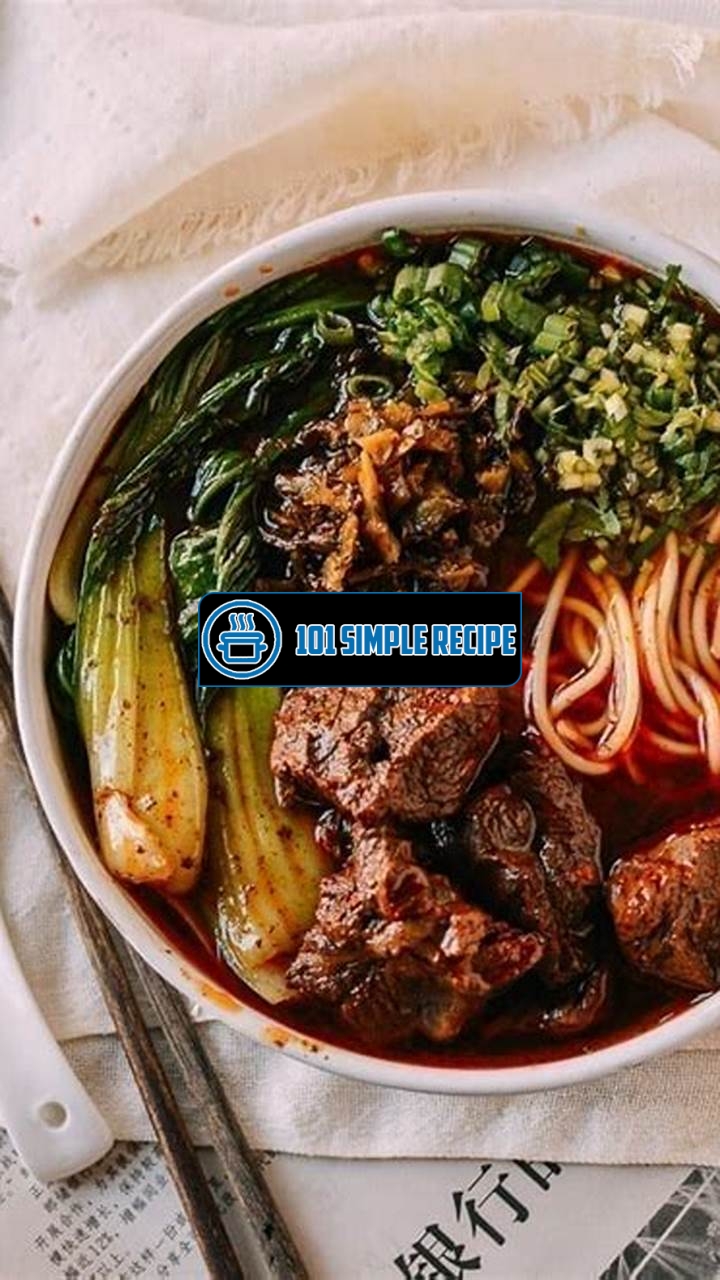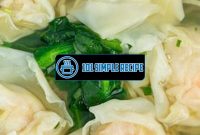Welcome to the ultimate guide on how to make authentic Singapore beef noodle soup! This beloved dish boasts a harmonious blend of flavors and textures that will transport you straight to the bustling streets of Singapore. Whether you are a seasoned chef or a novice in the kitchen, this recipe will equip you with all the essential tips and tricks to recreate this delectable dish in your own home. So, grab your apron and get ready to embark on a culinary adventure!

History of Singapore Beef Noodle Soup
In this article, we will delve into the fascinating history and cultural significance of Singapore’s beloved beef noodle soup. This iconic dish has a rich and diverse background that combines influences from various culinary traditions, resulting in a unique and flavorful bowl of noodles. Discover how this popular dish has evolved over time and become a staple in Singaporean cuisine.
The Origins of Beef Noodle Soup
The origins of beef noodle soup can be traced back to China, where it is believed to have originated in the northern regions. The dish was traditionally prepared using beef broth and hand-pulled noodles, often complemented with tender slices of beef. Over time, variations of the dish emerged, with different regions adding their own unique twists.
Fun Fact: Beef noodle soup is a staple in many Asian countries, including China, Taiwan, and Vietnam.
Influence of Chinese Cuisine
Chinese cuisine has had a profound influence on the development of Singaporean food culture, and beef noodle soup is no exception. As Chinese immigrants settled in Singapore, they brought with them their culinary traditions, including this hearty soup. The flavors and cooking techniques used in Chinese beef noodle soup laid the foundation for the Singaporean adaptation of the dish.
Cultural Note: In Chinese cuisine, the choice of noodles and the broth’s seasonings can vary depending on the region, resulting in distinct regional variations of beef noodle soup.
Singaporean Adaptation of the Dish
Singapore’s multicultural society has led to a blending of flavors and ingredients, creating a unique and vibrant food scene. The adaptation of beef noodle soup in Singapore reflects this diversity, incorporating elements from different culinary traditions.
One notable variation of Singaporean beef noodle soup is the addition of chili, which gives the dish a spicy kick. The use of fragrant spices and herbs, such as star anise, cinnamon, and cloves, infuses the broth with a delightful aroma. The noodles themselves are cooked to perfection, often with a springy texture that adds to the overall enjoyment of the dish.
Did You Know: Singaporean beef noodle soup is commonly served with tender and succulent beef slices, along with garnishes such as bean sprouts, coriander, and fried garlic.
Today, beef noodle soup has become a beloved comfort food in Singapore, enjoyed by locals and tourists alike. Its rich flavors and satisfying combination of noodles, broth, and beef make it a popular choice for a hearty meal.
In conclusion, the history of Singapore beef noodle soup is a testament to the culinary creativity and cultural blending of Singaporean cuisine. Through a fusion of Chinese influence and local adaptations, this dish has become a symbol of the country’s diverse culinary landscape. Whether enjoyed by locals or visitors, a steaming bowl of authentic Singapore beef noodle soup is sure to leave a lasting impression.
If you’re in the mood for something sweet, try this cookie in a mug recipe or this ranch oyster crackers recipe.
Key Ingredients for Singapore Beef Noodle Soup
Explore the essential components that make up the flavorful broth and toppings of this iconic dish.
The Perfect Broth
In order to create an authentic Singapore Beef Noodle Soup, the key is in the broth. The broth serves as the foundation of the soup, providing a rich and savory base that brings all the flavors together. To achieve the perfect broth, you will need a combination of ingredients and seasonings.
- Beef Bones: Start by sourcing high-quality beef bones. Beef knuckle bones or marrow bones work well for this soup, as they add depth and richness to the broth.
- Onion and Garlic: These aromatic vegetables are essential for flavoring the broth. Chop them roughly and add them to the pot.
- Ginger: Ginger adds a subtle warmth and depth to the broth. Peel and slice the ginger before adding it to the pot.
- Star Anise and Cinnamon: These spices provide a unique fragrance and flavor that is characteristic of Singapore Beef Noodle Soup. Add a few star anise pods and cinnamon sticks to the pot.
- Soy Sauce and Fish Sauce: These condiments add saltiness and umami to the broth. Adjust the amount according to your taste preference.
- Sugar: A small amount of sugar helps to balance the flavors and enhance the overall taste of the broth.
Simmer the ingredients together for at least 3 hours, allowing the flavors to meld and the broth to develop its rich taste. Skim off any impurities that rise to the surface during the simmering process for a clean and clear broth.
Tender Beef Cuts
Another crucial component of Singapore Beef Noodle Soup is the tender beef cuts. The choice of beef can make or break the dish, so it’s important to select the right cuts.
Traditionally, Singapore Beef Noodle Soup uses beef brisket, which is known for its flavorful and tender meat. The brisket is usually slow-cooked to achieve a melt-in-your-mouth texture. In addition to brisket, you can also use other cuts like beef shank, beef tendon, or even beef balls for added variety and texture.
To ensure the beef is tender and juicy, it’s recommended to marinate it with a mixture of soy sauce, garlic, and ginger before cooking. This helps to infuse the meat with flavors and tenderize it.
Delectable Noodle Varieties
The final component that completes the Singapore Beef Noodle Soup is the noodles. There are several noodle varieties to choose from, each offering a different texture and taste to the dish.
A classic choice is the thick and chewy egg noodles, also known as “mee pok” in Singapore. These noodles have a springy texture that complements the tender beef and robust broth. Another popular option is rice noodles, which are thin and delicate, allowing them to soak up the flavors of the soup.
Remember to cook the noodles according to the package instructions, as overcooking can result in mushy noodles. Rinse them under cold water after cooking to remove any excess starch and prevent them from sticking together.
By paying attention to these key ingredients – the perfect broth, tender beef cuts, and delectable noodle varieties – you can create an authentic and irresistible Singapore Beef Noodle Soup that will impress your family and friends. Enjoy!
Preparation Techniques for Singapore Beef Noodle Soup
In order to create an authentic and flavorful Singapore beef noodle soup, it is important to master the various preparation techniques. By following the right cooking methods and tips, you can achieve the perfect texture and taste for your homemade dish. Let’s dive into the three key steps: simmering the broth, marinating and cooking the beef, and preparing the noodles.
Simmering the Broth
The broth serves as the foundation of any good beef noodle soup, and simmering is the key technique to extract maximum flavor. Start by combining beef bones, onion, garlic, ginger, and spices such as star anise, cinnamon, and cloves in a pot. Fill the pot with water until the ingredients are fully submerged. Allow the broth to simmer on low heat for several hours, stirring occasionally.
During the simmering process, it is important to skim off any impurities or fat that rise to the surface. This will result in a cleaner and more flavorful broth. Additionally, you can enhance the taste by adding soy sauce, fish sauce, or beef bouillon cubes. The longer you simmer, the richer the flavors will become. Remember to adjust the seasoning according to your preference, ensuring a well-balanced broth.
Finally, strain the broth to remove any solids and achieve a clear and smooth texture. This flavorful broth will serve as the base for your Singapore beef noodle soup.
Marinating and Cooking the Beef
Marinating the beef is crucial to infusing it with flavor and tenderizing it for a succulent texture. Begin by selecting a suitable cut of beef, such as brisket or flank, and thinly slice it against the grain. This will ensure the meat remains tender even after cooking.
To marinate the beef, create a mixture of soy sauce, oyster sauce, garlic, ginger, and a touch of sugar. Coat the beef slices in the marinade and let it sit for at least 30 minutes, allowing the flavors to penetrate the meat.
When it comes to cooking the marinated beef, there are various methods to choose from. You can stir-fry the beef for a quick and flavorful option, or you can choose to braise it in the simmering broth for a more tender and melt-in-your-mouth result. Whichever method you choose, ensure that the beef is cooked to perfection and remains juicy and flavorful.
Preparing the Noodles
The choice of noodles can greatly influence the overall taste and texture of your Singapore beef noodle soup. Traditionally, thin rice noodles or wheat-based egg noodles are used. Prior to cooking, the noodles should be soaked in cold water to ensure they do not clump together.
Next, bring a pot of water to a boil and cook the noodles according to the package instructions. It is important to avoid overcooking the noodles as they should remain slightly firm. Once cooked, drain the noodles and rinse them with cold water to stop the cooking process and remove excess starch.
To serve, divide the cooked noodles into individual bowls and ladle the hot broth over them. Top the soup with the marinated and cooked beef slices, along with garnishes such as bean sprouts, fresh herbs, and sliced chili peppers. The addition of these toppings will add freshness and a hint of spiciness to your Singapore beef noodle soup.
Mastering the preparation techniques for Singapore beef noodle soup is key to creating a truly authentic and delicious dish. By simmering the broth, marinating and cooking the beef, and preparing the noodles with care and attention, you can enjoy a bowl of homemade goodness that is bursting with flavors and textures. So why not try your hand at preparing this iconic Singaporean dish in your own kitchen? We guarantee it will be a delightful culinary adventure!
If you’re looking for other delicious recipes, check out this White Castle recipe or this weight loss recipe.
Variations of Singapore Beef Noodle Soup
Discover the diverse regional and cultural adaptations of this dish, offering unique flavors and textures.
Malaysian Style Beef Noodle Soup
Malaysian-style beef noodle soup is a variation of the popular Singaporean dish that incorporates Malaysian flavors and ingredients. This version typically features a rich and aromatic broth made from a combination of beef bones, spices, and herbs. The broth is simmered for several hours to extract maximum flavor.
One key ingredient in Malaysian-style beef noodle soup is the use of beef shank, which adds a tender and flavorful element to the dish. The beef is usually sliced thinly and cooked in the broth until it becomes tender and succulent.
Additionally, Malaysian-style beef noodle soup often includes toppings such as bean sprouts, green onions, and cilantro. These fresh ingredients add a burst of crunch and freshness to the dish. Some variations may also include crispy fried onions or shallots for added texture and flavor.
A significant difference between Malaysian-style beef noodle soup and the Singaporean version is the use of different noodles. In Malaysia, it is common to use yellow egg noodles or rice noodles, which have a different texture and taste compared to the thick, chewy noodles typically used in Singaporean beef noodle soup.
Overall, Malaysian-style beef noodle soup offers a slightly different twist on the classic Singaporean dish, providing a unique and flavorful dining experience.
Indonesian Beef Noodle Soup
Indonesian-style beef noodle soup, also known as Bakmi Sapi, is another delicious variation of this popular dish. The Indonesian version typically features a spicier flavor profile and incorporates Indonesian spices and herbs.
The broth of Indonesian beef noodle soup is often infused with fragrant spices such as cloves, star anise, and cinnamon. These spices add warmth and depth to the broth, creating a comforting and aromatic dish.
Similar to the Malaysian-style version, Indonesian beef noodle soup uses beef shank as the main protein. The beef is slow-cooked in the flavorful broth until it becomes tender and infused with the fragrant spices.
Indonesian beef noodle soup is typically served with various toppings, including sliced beef, bean sprouts, bok choy, and fried shallots. The dish is often garnished with cilantro and served with a side of sambal, a spicy chili sauce that adds an extra kick of heat.
While the Indonesian version shares some similarities with Singaporean beef noodle soup, the unique combination of Indonesian spices and flavors makes it a distinct and tantalizing dish on its own.
Vegetarian and Vegan Options
For those who prefer a vegetarian or vegan alternative to the traditional beef noodle soup, there are plenty of options available.
One popular vegetarian version substitutes the beef with tofu or seitan, a meat substitute made from wheat gluten. These protein sources can be marinated and cooked in a flavorful broth to mimic the texture and taste of beef.
Vegetables such as mushrooms, bok choy, and bean sprouts can also be added to the broth to create a hearty and nutritious vegetarian dish. These ingredients add a variety of textures and flavors to the soup.
Vegan versions often omit the use of eggs and dairy products, such as fish sauce or oyster sauce, which are commonly included in traditional recipes. Instead, alternative seasonings like soy sauce or miso paste can be used to enhance the flavor of the broth.
The vegetarian and vegan variations offer a healthier and cruelty-free alternative to the classic beef noodle soup, ensuring that everyone can enjoy this beloved dish.
If you’re a dog owner, you might be interested in this dog food nature’s recipe or this borax ant killer recipe.
Serving and Garnishing Singapore Beef Noodle Soup
When it comes to serving and garnishing Singapore Beef Noodle Soup, presentation is key. Elevate this dish to a culinary masterpiece by exploring the art of presentation and incorporating the right toppings. Here are a few elements to consider:
Fresh Herbs and Greens
Add a touch of freshness and vibrant flavors to your Singapore Beef Noodle Soup by garnishing it with fresh herbs and greens. These ingredients not only enhance the visual appeal of the dish but also add a burst of flavor. Consider adding the following to your soup:
- Coriander: This aromatic herb adds a fragrant and earthy taste, enhancing the overall flavor profile of the soup.
- Thai Basil: Known for its unique licorice-like flavor, Thai basil adds a refreshing twist to the dish.
- Bean Sprouts: These crunchy sprouts provide a satisfying texture and a hint of freshness.
By incorporating these fresh herbs and greens, you’ll infuse your Singapore Beef Noodle Soup with an added layer of complexity and visual appeal. Plus, you’ll create a delightful balance of flavors that will leave your taste buds craving for more.
Condiments for Added Flavor
Level up the taste of your Singapore Beef Noodle Soup by including a variety of condiments. These flavor enhancers can be customized to suit individual preferences and add a unique touch to each bowl of soup. Here are some popular condiments to consider:
- Chili Sauce: Add a spicy kick to your soup with a dollop of chili sauce. Whether you prefer it mild or fiery, this condiment will certainly elevate the heat level.
- Soy Sauce: For an umami-rich flavor, drizzle some soy sauce into your Singapore Beef Noodle Soup. It adds depth and a savory taste that complements the beef and noodle combination perfectly.
- Lime Juice: Squeeze some fresh lime juice into your bowl of soup to brighten up the flavors and add a tangy twist.
These condiments not only enhance the taste of the soup but also provide an opportunity for personalization. Each spoonful becomes a unique experience, allowing you to tailor the flavors to your liking.
Traditional Side Dishes
In Singapore, it’s common to serve side dishes alongside the Singapore Beef Noodle Soup. These complementary dishes enhance the dining experience and offer a variety of textures and flavors. Some popular choices include:
- Spring Rolls: Crispy and filled with a medley of vegetables and meat, spring rolls make the perfect accompaniment to the soup. Their crunchiness provides a delightful contrast to the rich and hearty broth.
- Chicken Satay: Skewered and grilled chicken satay adds a smoky and savory element to the meal. Dip them in peanut sauce for an extra burst of flavor.
- Steamed Dumplings: These bite-sized delights are filled with juicy meat and flavorful broth. They offer a satisfying texture and are often enjoyed with a dipping sauce.
By serving traditional side dishes with your Singapore Beef Noodle Soup, you’ll create a multi-dimensional dining experience. These additional elements add variety and excitement to the meal, making it a truly satisfying and memorable feast.
Remember, the art of serving and garnishing Singapore Beef Noodle Soup lies in the details. From fresh herbs and greens to flavorful condiments and traditional side dishes, every element contributes to the overall experience. So, unleash your creativity and take your soup to the next level!
Thank you for taking the time to read our article on the Singapore beef noodle soup recipe. We hope you found it informative and inspiring to try this delicious dish at home. If you enjoyed this recipe, we encourage you to visit our website again for more exciting recipes and culinary adventures. Remember, food is not just sustenance; it’s an experience that brings people together and creates memories. So, gather your loved ones, put on your apron, and let the aromas of this flavorful soup fill your kitchen. Until next time, happy cooking!
Frequently Asked Questions
Here are some frequently asked questions about the Singapore beef noodle soup recipe:
| No. | Questions | Answers |
|---|---|---|
| 1. | Can I use chicken instead of beef for this recipe? | Yes, you can certainly substitute chicken for beef in this recipe. The flavors will be slightly different, but it will still be a delicious noodle soup. |
| 2. | Can I make this soup vegetarian-friendly? | Absolutely! You can use vegetable stock instead of beef broth and add your favorite vegetables and tofu for a tasty vegetarian version of this soup. |
| 3. | How spicy is this soup? | The level of spiciness can be adjusted to your preference. You can add more or less chili paste or chili flakes to make it mild or spicy. |
| 4. | Can I freeze the leftovers? | Yes, you can freeze the leftover soup in an airtight container for up to three months. Just make sure to let it cool completely before freezing. |
| 5. | What are some optional toppings for this soup? | Some popular toppings for Singapore beef noodle soup include fresh cilantro, chopped green onions, fried shallots, and a squeeze of lime. |
| 6. | Can I make this soup in a slow cooker? | Yes, you can adapt this recipe for a slow cooker. Just follow the instructions and cook on low heat for 6-8 hours or until the beef is tender. |
Singapore Beef Noodle Soup Recipe
Here is the delicious recipe for Singapore beef noodle soup:
Jump to Recipe
Singapore Beef Noodle Soup

Learn how to make the authentic Singaporean beef noodle soup at home with this easy recipe. The rich broth, tender beef, and flavorful noodles will transport you to the streets of Singapore.
- 500 g beef slices
- 200 g rice noodles
- 1 liter beef broth
- 2 tablespoons soy sauce
- 1 tablespoon fish sauce
- 1 tablespoon oyster sauce
- 1 tablespoon vegetable oil
- 1 onion (sliced)
- 3 cloves garlic (minced)
- 1 thumb-sized ginger (sliced)
- 1 red chili (sliced)
- 1 tablespoon chili paste
- 2 tablespoons chopped cilantro
- Lime wedges (for serving)
- In a large pot, heat the vegetable oil over medium-high heat. Add the onions, garlic, ginger, and red chili. Cook until fragrant, about 2-3 minutes.
- Add the beef slices and cook until browned, about 2-3 minutes per side. Remove the beef from the pot and set aside.
- In the same pot, add the beef broth, soy sauce, fish sauce, oyster sauce, and chili paste. Bring to a boil, then reduce heat and simmer for 30 minutes.
- While the broth is simmering, cook the rice noodles according to package instructions. Drain and set aside.
- Once the broth is ready, return the beef slices to the pot and cook for an additional 5 minutes, or until the beef is cooked to your desired level of doneness.
- To serve, divide the cooked rice noodles among bowls. Ladle the hot soup over the noodles, making sure to include some beef slices in each bowl. Garnish with chopped cilantro and serve with lime wedges on the side.






